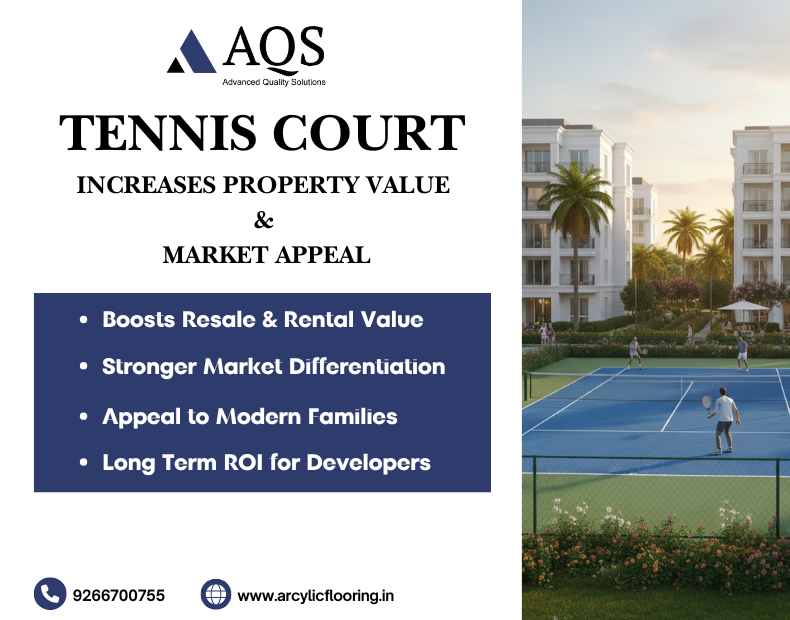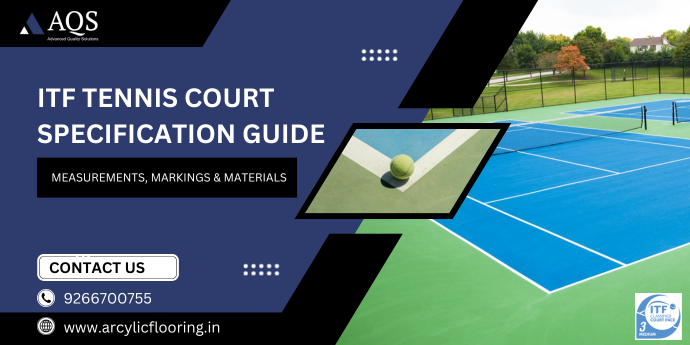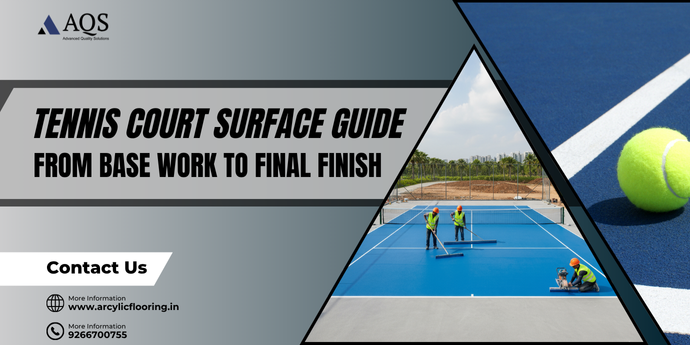In India, housing societies are no longer just about flats and security. They’re becoming lifestyle hubs where residents can enjoy wellness, recreation and community engagement without leaving the premises. Among the many amenities available, a tennis court is one of the best investments for housing society. Tennis is growing in popularity among kids, working professionals and fitness enthusiasts.
Having a sports court within a gated community gives residents a healthier lifestyle, stronger social bonds and increased property value. At AQS (Advanced Quality Solutions), we specialize in synthetic acrylic tennis court construction for modern housing societies across India. In this blog we will see how a tennis court flooring benefits residents, management committee and property developers.
1. Health & Fitness for All Age Groups
Having a community tennis court in your housing society is one of the biggest advantages for the residents’ health and lifestyle. In today’s world having a sports facility right next to you encourages everyone to stay active without going to gyms or clubs.
For Children:
Children benefit most when having a tennis court in their society. Tennis develops skills, hand-eye coordination, agility and balance which are important for physical and cognitive development. It also teaches discipline, focus and teamwork qualities that go beyond sports and contribute to overall personality growth. When children start playing early they lay the foundation for lifelong fitness.
For Adults:
Working professionals spend long hours at desks and get stressed, exhausted and facing health issues like back pain or poor posture. Tennis is a stress-relieving workout that combines cardio, strength and coordination in a fun way. Unlike gym routines, playing tennis with friends, neighbors or family keeps adults motivated to stay active. A quick game in the evenings or weekends is both exercise and recreation and makes it easier to maintain work-life balance.
For Seniors:
Older residents are unable to play high intensity games. But tennis is a safe, enjoyable and low-impact fitness option. Gentle games or doubles matches help seniors stay mobile, improve flexibility and maintain health without putting too much strain on joints. The social aspect of the game also combats loneliness and keeps seniors engaged and connected within the community.
In short, a tennis court is not just a facility, it’s an investment in the health and well-being of the entire community so that everyone from children to seniors has a reason to stay fit and active.
2. Community Bonding
Having a community tennis court flooring in a housing society is one of the best ways to strengthen social ties among residents. Unlike passive amenities like a clubhouse or garden seating area, a tennis court encourages active participation and collaboration and brings people together in meaningful ways.
- Families Creating Memories
Weekends become special when families step out together for a casual game of tennis. Parents can introduce the sport to their kids, siblings can play doubles together, and grandparents can watch and cheer from the sidelines. These shared experiences create family memories within the society itself.
- Organized Matches & Tournaments
Residents come together to organize friendly matches, building challenges or society-level tournaments. These events add excitement and provide opportunities for residents who may not otherwise interact to connect and bond. Matches turn into mini-festivals with viewers, snacks and celebrations, making you feel like you live in a vibrant community.
- Safe Play Area for Kids
In many housing societies, one of the biggest concerns for parents is to provide a safe and structured play area for kids. A community tennis court addresses this by providing a secure, supervised space for kids to learn, practice and socialize after school. Unlike open grounds where safety is a concern, a fenced and well maintained tennis court gives parents peace of mind.
- Building a Stronger Neighborhood
A tennis court becomes the central point of the community where people come not just to play but to watch matches, host events or just hang out. Over time this regular interaction builds trust, friendships and camaraderie among residents making the housing society more social and lively.
The saying goes when people share physical activities, their sense of belonging increases. A tennis court is more than a sports facility; it’s a social hot spot where residents of all ages bond over the game.

3. Increases Property Value & Market Appeal
For developers and resident welfare associations (RWAs), a tennis court is more than “just another amenity.” It’s a value-addition that impacts both market and long term property appreciation.
- Boosts Resale & Rental Value
Properties in housing societies with dedicated sports facilities, especially a community tennis court, command higher resale prices. Buyers see these societies as modern, lifestyle focused and family friendly. Even rental units in such projects are in higher demand and often command premium rates compared to projects without sports amenities. - Stronger Market Differentiation
In competitive urban real estate markets, developers are always looking for ways to transform their projects. A tennis court not only sets a project apart from other residential complexes but also positions it as a premium, wellness oriented community. This positioning translates into faster sales cycles and greater brand recognition. - Appeal to Modern Families
Today’s families, especially young parents, are looking for outdoor tennis court recreation options for their kids. A tennis court provides a safe, structured and health oriented activity space right within the society, eliminating the need to travel to clubs or academies. For buyers rating multiple projects, the presence of a sports tennis court can often be the deciding factor. - Long Term ROI for Developers
While the cost to build a tennis court may seem high initially, the long term return on investment is huge. Incorporate sports amenities like community tennis courts have been shown to increase residence rates, improve resident retention and reduce turnover. For developers this means higher sales and a stronger brand that helps future projects sell better. - Brand Value
Housing societies with tennis courts are seen as modern, premium and lifestyle driven. For developers an enduring brand image as a company that delivers not just homes but complete living environments. Over time this becomes a powerful tool for marketing and project success.
In short a community tennis court is not an expense but a strategic investment that benefits both current residents and future property stakeholders.
4. Year-Round Tennis Court Usability with Synthetic Flooring
India’s climate is varied as culture, heating summers in the north, heavy monsoons along the coasts, and humid conditions in central and southern cities. This diversity poses a challenge for outdoor sports infrastructure, especially when it comes to building durable tennis courts in housing societies. That’s where synthetic tennis court flooring is the most reliable option, offering consistency, safety and playability throughout the year.
Acrylic Flooring:
Among the various flooring systems, acrylic tennis court flooring is the most practical solution for housing societies.
- Weather-Resistant: Designed to withstand extreme temperatures and UV exposure without fading or cracking.
- Slip-Proof & Cushioned: Minimizes the risk of injuries for both adults and children while offering comfort during long playing sessions.
- Certified Quality: ITF-approved and ISO-certified acrylic layers make sure professional performance while meeting international safety standards.
This makes acrylic flooring the go-to option for communities that need affordability and long lasting durability.
Asphalt Tennis Court Construction:
While acrylic coats are the top layer, the base construction is equally important. Asphalt is one of the most widely used bases for housing society tennis courts.
- Durability: Provides a stable foundation for the acrylic system.
- Cost-Effective: More budget friendly than concrete while still offering good performance.
- Seamless Pairing: Works well with acrylic surfacing, giving residents a tennis court that remains strong under heavy use.
When constructed by expert tennis court builders, asphalt bases with acrylic finishes create tennis courts that can withstand daily foot traffic and unpredictable weather.
Resurfacing Options for Longevity
Even the best courts need attention. Synthetic systems are relatively easy to refresh compared to grass or clay courts. Housing societies can plan resurfacing every 5-7 years to restore grip, cushioning and aesthetics.
- Resurfacing Materials: High quality acrylic resurfacers, cushion coats and color finishes are used to renew the surface.
- Cost Efficient Maintenance: Instead of rebuilding, resurfacing extends the court’s life at a fraction of the construction cost.
Visual Appeal: Fresh coatings also revive the court’s colors, making the facility look attractive for residents.
5. Long Term Investment
One of the biggest concerns raised by Resident Welfare Associations (RWAs) and housing society management committees is the cost of building a tennis court. While the idea of building a sports facility may seem like a big investment at first, modern construction techniques and synthetic acrylic flooring systems have made tennis courts very affordable for community projects.
- Basic Outdoor Courts: These are ideal for smaller housing societies or projects with limited open space. With a strong asphalt or concrete base and standard acrylic surfacing, these courts give a professional playing experience without burning a hole in your pocket.
- Premium Cushioned Courts: Larger residential complexes opt for cushioned acrylic systems with multiple shock absorbing layers. These courts not only give better player comfort but also increase the life of the court making them a good long term investment for community use.
What makes tennis courts affordable is the cost sharing model. In most housing societies the cost is shared among hundreds of residents. So the actual cost per household is negligible when compared to the benefits—a safe, professional grade sports facility right at your doorstep.
6. Safe & Inclusive Sports Environment
Safety is the top concern for housing societies when it comes to recreational facilities, especially in areas where children and senior residents will be active. Unlike makeshift play areas or uneven open spaces, a professionally built synthetic tennis court ensures a safe and structured environment for all.
Cushioned Flooring for Reduced Impact
Tennis involves quick movements, sudden stops and frequent changes in direction. Playing on hard or uneven surfaces can lead to sprains, knee strain or back problems. With cushioned acrylic tennis court flooring, players experience reduced stress on joints, so it’s suitable for young children and older adults who want to stay active without getting injured.
Slip-Resistant, All-Weather Play
In India’s climate, outdoor surfaces are exposed to dust, heat and rain. Traditional concrete or tiled surfaces get slippery during monsoons and increase the chances of accidents. Slip-resistant tennis court flooring provides excellent grip even in slightly damp conditions, so the court is safe to play all year round.
Structured Layout with Clear Markings
A good court is more than just flooring – it’s about precision. Professionally applied line markings define boundaries clearly, so there’s no dispute and structured play. Children learn discipline, adults get the satisfaction of a well-organized game environment.
Inclusivity Across Age Groups
Unlike high-impact sports or facilities that cater to limited demographics, a tennis court is truly inclusive. Kids can play for recreation, working professionals can use it as a fitness activity after work and senior citizens can play in a safe, controlled environment that encourages movement without excessive strain.
Prevention of Common Hazards
Poorly constructed or temporary courts have uneven patches, cracks or sharp edges that put players at risk. By working with expert tennis court builders, housing societies eliminate these hazards and give residents the peace of mind that their recreational facilities are designed with safety as priority.
In short, a synthetic acrylic tennis court turns housing society spaces into safe, inclusive and enjoyable environments. So every resident – from the youngest to the oldest can play, exercise and socialise without worrying about accidents or injuries.
7. Adds Cachet to the Society
Housing societies with community tennis courts are seen as offering top notch, international standard facilities. In today’s competitive real estate market, amenities are a big differentiator for a project. A well built tennis court says that the society values quality living, modern recreation and community well being. This cachet translates to lifestyle enhancement for current residents and long term value for property owners.
A tennis court is also a visual statement of luxury and wellness—something that prospective buyers notice immediately during site visits. Families look for housing projects that offer outdoor sports and fitness facilities as these reflect a healthier and more balanced lifestyle.
Ultimately a community tennis court is more than just a recreational space—it’s a status symbol that raises the profile of the housing society, increases its marketability and reflects commitment to wellness and active living.
Why AQS for Community Tennis Court Construction?
- Tennis Court Construction Experience: With years of experience in tennis court construction in India, AQS has completed projects for schools, academies, clubs and housing societies.
- Certified Materials: A tennis court is only as good as the materials used. At AQS, we use only ISO certified and ITF approved acrylic systems.
- Custom Designs: Every housing society is different—some may need a full size court for competitive play while others may want a multi purpose court for kids and casual players. AQS offers custom design solutions based on space, budget and resident requirements.
- End to End Services: Building a tennis court is more than just laying a surface. AQS provides comprehensive end to end services.
- Resurfacing & Repairs: A tennis court is a long term investment and maintenance is key to extending its life. Over time cracks, fading and surface wear are inevitable. That’s why AQS provides resurfacing and repair services with high quality tennis court resurfacing products.
- Transparent Pricing: Budget overruns are a common worry for RWAs and developers. At AQS, we are transparent with our pricing and provide a detailed breakdown of the tennis court construction cost.
By partnering with AQS, housing societies get a functional tennis court and a long term community asset that adds to resident lifestyle.
Conclusion
A community tennis court is more than just a sports facility—it’s a place that promotes fitness, builds relationships, increases property value and prestige of housing societies. For residents it’s convenient and a safe place to live healthy. For developers and RWAs it’s an investment that gives back in higher occupancy, resale value and community satisfaction.
With the right tennis court builders and certified materials, housing societies can have a durable and low maintenance court for everyone. At AQS we build professional tennis courts that turn residential projects into happening communities.
Frequently Asked Questions
A tennis court is for fitness, social bonding, property value and to make the society more attractive to modern families.
It improves hand-eye coordination, agility, discipline and teamwork and gives kids a safe play area within the society.
Yes, tennis is stress relief, cardio and strength training for adults and low-impact exercise for seniors that improves mobility and reduces loneliness.
Synthetic acrylic flooring is best as it is ITF approved, weather resistant, cushioned, slip proof and durable across India’s climate.
Costs are shared among residents making it very affordable. Basic acrylic courts are cost effective and cushioned systems offer long term value.
Resurfacing is recommended every 5-7 years to maintain grip, comfort and aesthetics at a fraction of the cost of rebuilding.




